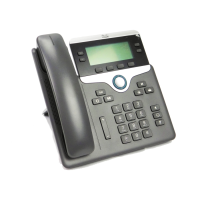Step 5
Click Save.
Step 6
Click Apply Config.
Related Topics
Cisco Unified Communications Manager Documentation, on page xiii
Mobile and Remote Access Through Expressway
Mobile and Remote Access Through Expressway lets remote workers easily and securely connect into the
corporate network without using a virtual private network (VPN) client tunnel. Expressway uses Transport
Layer Security (TLS) to secure network traffic. For a phone to authenticate an Expressway certificate and
establish a TLS session, the Expressway certificate must be signed by a public Certificate Authority that is
trusted by the phone firmware. It is not possible to install or trust other CA certificates on phones for
authenticating an Expressway certificate.
The list of CA certificates embedded in the phone firmware is available at http://www.cisco.com/c/en/us/
support/collaboration-endpoints/unified-ip-phone-7800-series/products-technical-reference-list.html.
Mobile and Remote Access Through Expressway works with Cisco Expressway so you should be familiar
with the Cisco Expressway documentation, including the Cisco Expressway Administrator Guide and the
Cisco Expressway Basic Configuration Deployment Guide.
Only the IPv4 protocol is supported for Mobile and Remote Access Through Expressway users.
For additional information about working with Mobile and Remote Access Through Expressway see:
•
Cisco Preferred Architecture for Enterprise Collaboration, Design Overview
•
Cisco Preferred Architecture for Enterprise Collaboration, CVD
•
Unified Communications Mobile and Remote Access via Cisco VCS Deployment Guide
•
Cisco TelePresence Video Communication Server (VCS), Configuration Guides
During the phone registration process, the phone synchronizes the displayed date and time with the Network
Time Protocol (NTP) server. With Mobile and Remote Access Through Expressway, the DHCP option 42
tag is used to locate the IP addresses of the NTP servers designated for time and date synchronization. But if
the DHCP option 42 tag is not found in the configuration information, the phone looks for the
0.tandberg.pool.ntp.org tag to identify the NTP servers.
After registration, the phone uses information from the SIP message to synchronize the displayed date and
time unless there is an NTP server configured in the Cisco Unified Communications Manager phone
configuration.
If the phone security profile for any of your phones have TFTP Encrypted Config checked, you cannot
use the phone with Mobile and Remote Access. This limitation is because the MRA solution does not
support devices interacting with CAPF (Certificate Authority Proxy Function).
Note
Cisco IP Phone 7800 Series Administration Guide for Cisco Unified Communications Manager
156
Phone Feature Configuration

